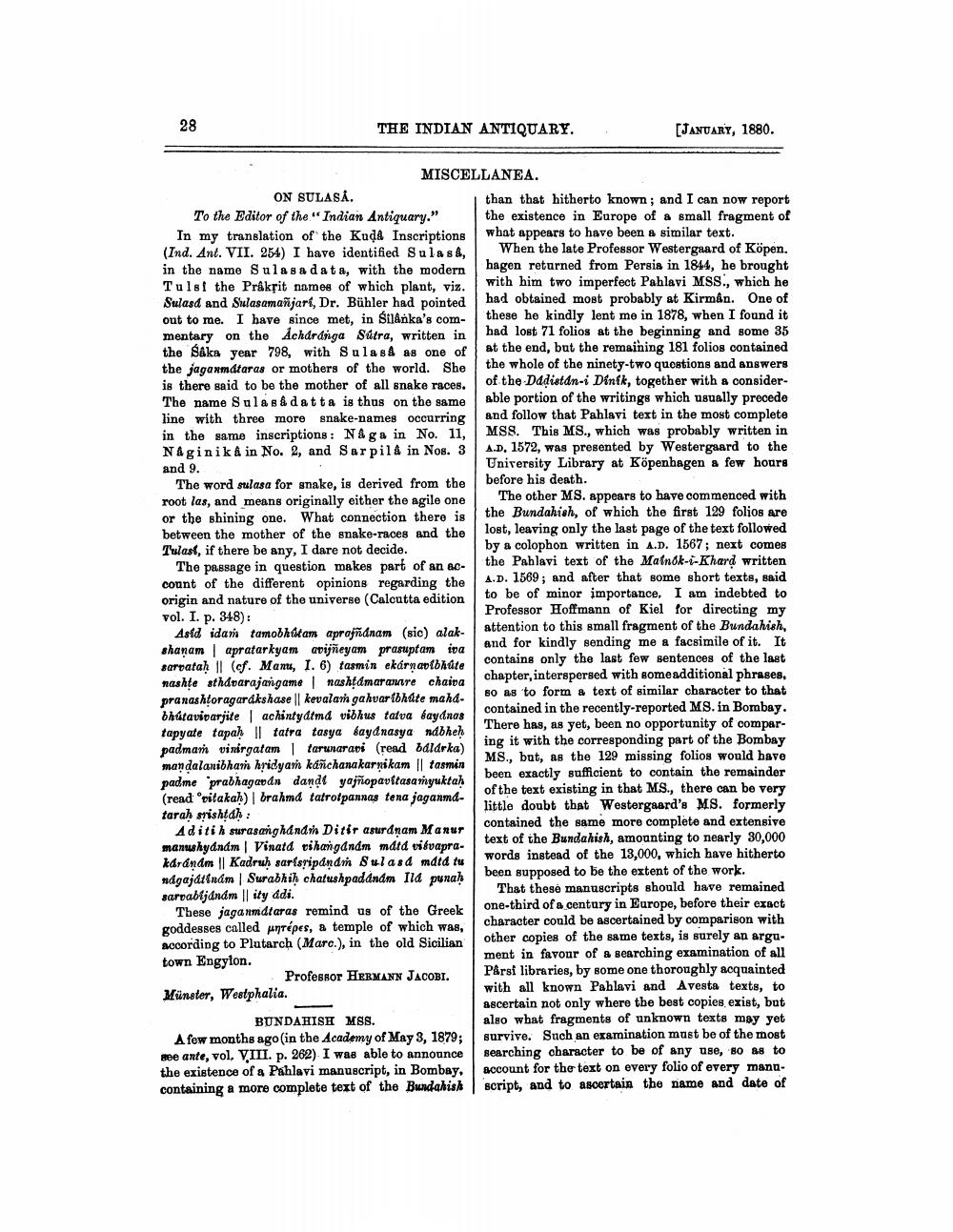________________
THE INDIAN ANTIQUARY.
(JANUARY, 1880.
MISCELLANEA. ON SULASA.
than that hitherto known; and I can now report To the Editor of the "Indian Antiquary." the existence in Europe of a small fragment of In my translation of the Kuda Inscriptions what appears to have been a similar text. (Ind. Ant. VII. 254) I have identified Sulasa, When the late Professor Westergaard of Köpen. in the name Sulasa data, with the modern hagen returned from Persia in 1844, he brought Tulsi the Prakrit names of which plant, viz. with him two imperfect Pahlavi MSS., which he Sulasd and Sklasamañjart, Dr. Bühler had pointed had obtained most probably at Kirman. One of out to me. I have since met, in Silånka's com- these he kindly lent me in 1878, when I found it mentary on the Achdránga Satra, written in had lost 71 folios at the beginning and some 35 the Saka year 798, with Sulas A as one of at the end, but the remaining 181 folios contained the jaganmdtaras or mothers of the world. She the whole of the ninety-two questions and answers is there said to be the mother of all snake races.
of the Dadistdn-i Dink, together with a considerThe name Sulas&datta is thus on the same
able portion of the writings which usually precede line with three more snake-names occurring and follow that Pahlavi text in the most complete in the same inscriptions : Någa in No. 11, MSS. This MS., which was probably written in Naginik & in No. 2, and Sar pild in Nos. 3 A.D. 1572, was presented by Westergaard to the and 9.
University Library at Köpenhagen a few hours The word sulasa for snake, is derived from the before his death. root las, and means originally either the agilo one
The other MS. appears to have commenced with or the shining one. What connection there is the Bundahish, of which the first 129 folios are between the mother of the snake-races and the
lost, leaving only the last page of the text followed Tulast, if there be any, I dare not decide.
by a colophon written in A.D. 1567; next comes The passage in question makes part of an ac
the Pahlavi text of the Mainok-i-Khard written connt of the different opinions regarding the A.D. 1569; and after that some short texts. sajd origin and nature of the universe (Calcutta edition
to be of minor importance, I am indebted to vol. I. p. 348):
Professor Hoffmann of Kiel for directing my Asid idaria tamobhitam aprofñanam (sic) alak
attention to this small fragment of the Bundahish, shanam | apratarkyam avijñeyam prasuptam iva
and for kindly sending me a facsimile of it. It sartatah || (cf. Manus, I. 6) tasmin ekárnaplóhúte
contains only the last few sentences of the last nashte sthadarajasigame mashtamar amire chaira
chapter, interspersed with some additional phrases, pranashtoragardkshase || kevalarh gahvarfohdte mahd
so as to form a text of similar character to that bhataviparjiteachintydtmd vibhus tatva bayanas
contained in the recently-reported MS. in Bombay. tapyate tapah Il tatra tasya baydnasyandbheh
There has, as yet, been no opportunity of comparpadman vinirgatam tarunaravi (read baldrka)
ing it with the corresponding part of the Bombay
MS., but, as the 129 missing folios would have mandalanibhar hridyan kañchanakarnikam || tasmin padme "prabhagavdn dandt yajñopavítasariyuktah
been exactly sufficient to contain the remainder (read 'vitakah) brahmd tatrotpannas tena jaganmd
of the text existing in that Ms., there can be very tarah syishtah:
little doubt that Westergaard's MS. formerly Aditih surasanghandin Ditir asurdnam Manut
contained the same more complete and extensive manushyanam | Vinata rihangandm mdtd vilvapra
text of the Bundahish, amounting to nearly 30,000 kdrandm || Kadruh sarísripandr Sulasd mdid tu
words instead of the 13,000, which have hitherto ndgajatenam Surabhiḥ chatushpadanam Ila punah
been supposed to be the extent of the work. sarvabljdndm Ility ddi.
That these manuscripts should have remained These jaganmdiaras remind us of the Greek
one-third of a century in Europe, before their exact goddesses called unrépes, a temple of which was, character could be ascertained by comparison with according to Plutarch (Marc.), in the old Sicilian
other copies of the same texts, is surely an argutown Engyton.
ment in favour of a searching examination of all Professor HERMANN JACOBI. PÅrsf libraries, by some one thoroughly acquainted Münster, Westphalia.
with all known Pahlavi and Avesta texts, to
ascertain not only where the best copies exist, but BUNDAHISH MSS.
also what fragments of unknown texts may yet A few months ago in the Academy of May 3, 1879; survive. Such an examination must be of the most we ante, vol. VIII. p. 262) I was able to announce searching character to be of any use, 80 88 to the existence of a Pahlavi manuscript, in Bombay, account for the text on every folio of every manacontaining a more complete text of the Bundahish script, and to ascertain the name and date of




